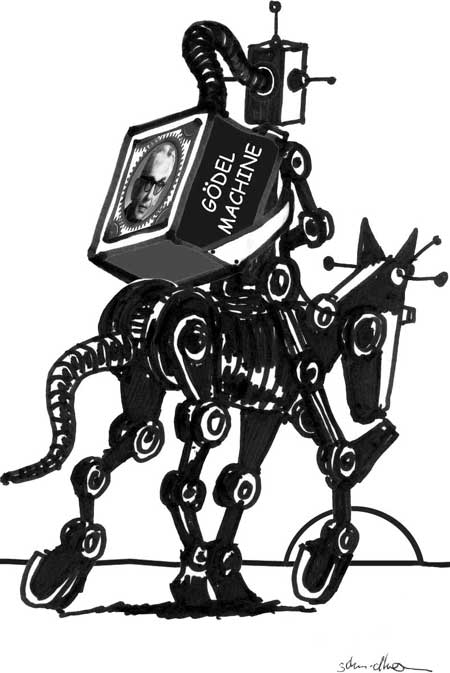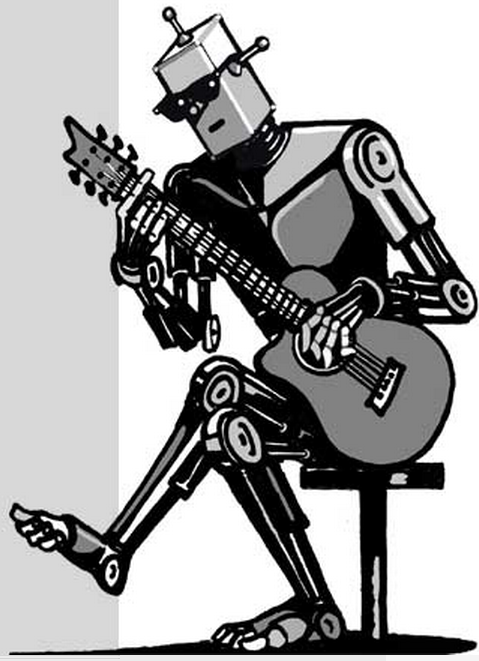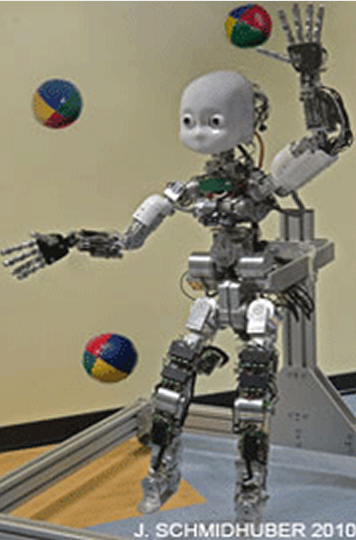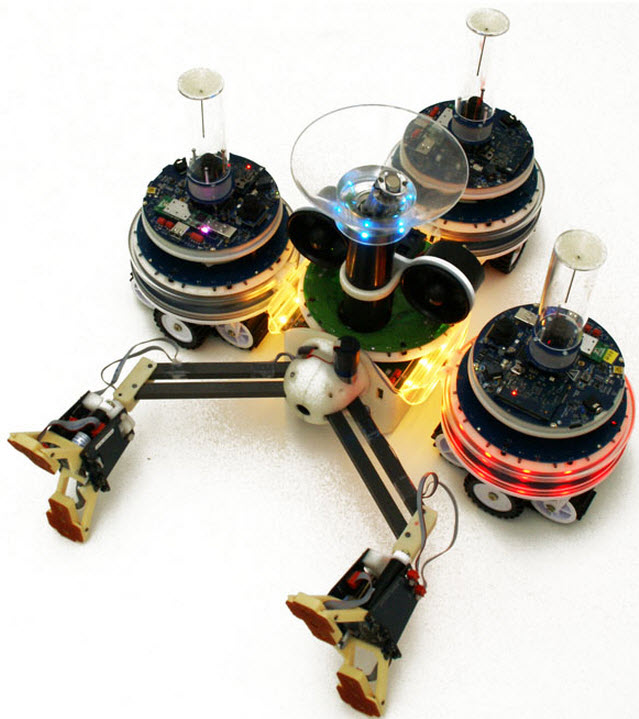When creative machines overtake man
March 31, 2012
Machine intelligence is improving rapidly, to the point that the scientist of the future may not even be human! In fact, in more and more fields, learning machines are already outperforming humans. As noted in this transcript of a talk at TEDxLausanne on Jan. 20, 2012, artificial intelligence expert Jürgen Schmidhuber isn’t able to predict the future accurately, but he explains how machines are getting creative, why 40‚000 years of Homo sapiens-dominated history are about to end soon, and how we can try to make the best of what lies ahead.
When I was a boy, I wanted to become a physicist like my hero Einstein until I realized as a teenager the much bigger impact of building a scientist smarter than myself (my colleagues claim that should be easy), letting him do the remaining work.
So I became an artificial intelligence researcher. It’s a good time to be one; it looks like AI will help to make 40,000 years of human-dominated history converge around the year 2040, which I call Omega. Some call it “the Singularity,” but I prefer Omega, because that’s what Teilhard de Chardin called it 100 years ago, and because it sounds so much like “Oh my God.”
 Acceleration of key events in human history
Acceleration of key events in human history
Let me show you this pattern of exponential acceleration of the most important events in human history, which started 40,000 years ago with the emergence of Homo Sapiens Sapiens from Africa.
 We take a quarter of this time: Omega minus 10,000 years. That’s precisely the next big chapter in the history books: emergence of civilization, agriculture, domestication of animals, first villages.
We take a quarter of this time: Omega minus 10,000 years. That’s precisely the next big chapter in the history books: emergence of civilization, agriculture, domestication of animals, first villages.
 And we take a quarter of this time: Omega – 2500 years. That’s precisely the Axial Age, as Jaspers called it: major religions founded in India and China and the West (Old Testament); the ancient Greeks lay the foundations of the Western world — formal reasoning, sophisticated machines including steam engines, anatomically perfect sculptures, harmonic music, organized sport, democracy.
And we take a quarter of this time: Omega – 2500 years. That’s precisely the Axial Age, as Jaspers called it: major religions founded in India and China and the West (Old Testament); the ancient Greeks lay the foundations of the Western world — formal reasoning, sophisticated machines including steam engines, anatomically perfect sculptures, harmonic music, organized sport, democracy.
 And we take a quarter of this time. That’s precisely the next big advance: the Renaissance; beginnings of the scientific revolution; invention of the printing press (often called the most influential invention of the past 1000 years); age of exploration, first through Chinese fleets, then also European explorers such as Columbus, who did not become famous because he was the first to discover America, but because he was the last.
And we take a quarter of this time. That’s precisely the next big advance: the Renaissance; beginnings of the scientific revolution; invention of the printing press (often called the most influential invention of the past 1000 years); age of exploration, first through Chinese fleets, then also European explorers such as Columbus, who did not become famous because he was the first to discover America, but because he was the last.
 And we take a quarter of this time: Omega – 2 human lifetimes: the late 19th century; emergence of the modern world (many still existing companies were founded back then); invention of combustion engines and cars, cheap electricity, modern chemistry; germ theory of disease revolutionizes medicine; Einstein born; and the biggest event of them all: the onset of the population explosion from 1 billion to soon 10 billion, through fertilizer and then artificial fertilizer.
And we take a quarter of this time: Omega – 2 human lifetimes: the late 19th century; emergence of the modern world (many still existing companies were founded back then); invention of combustion engines and cars, cheap electricity, modern chemistry; germ theory of disease revolutionizes medicine; Einstein born; and the biggest event of them all: the onset of the population explosion from 1 billion to soon 10 billion, through fertilizer and then artificial fertilizer.
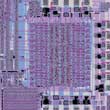 And we take a quarter of this time: Omega – 1/2 lifetime. That’s the year 2000: the emerging digital nervous system covers the world; WWW and cheap computers and cell phones for everybody; the information processing revolution.
And we take a quarter of this time: Omega – 1/2 lifetime. That’s the year 2000: the emerging digital nervous system covers the world; WWW and cheap computers and cell phones for everybody; the information processing revolution.
And we take a quarter of this time: Omega – 10 years. Now that’s in the future. Many have learned the hard way that it’s difficult to predict the future, including myself and the guy responsible for my investments.
Nevertheless, a few things can be predicted confidently, such as: soon there will be computers faster than human brains, because computing power will continue to grow by a factor of 100–1000 per decade per Swiss Franc (or a factor of 100 per Dollar, because the Dollar is deflating so rapidly).
Computers that solve problems better than humans
Now you say: OK, computers will be faster than brains, but they lack the general problem-solving software of humans, who apparently can learn to solve all kinds of problems!
But that’s too pessimistic. At the Swiss AI Lab IDSIA in the new millennium we already developed mathematically optimal, learning, universal problem solvers living in unknown environments (more, even more).
That is, at least from a theoretical point of view, blueprints of universal AIs already exist. They are not yet practical for various reasons; but on the other hand we already do have not quite as universal, but very practical brain-inspired artificial neural networks that are learning complex tasks that seemed unfeasible only 10 years ago.
In fact, the recurrent or deep neural nets developed in my lab are currently winning all kinds of international machine learning competitions. For example, they are now the best methods for recognizing connected French handwriting. And also Arabic handwriting. And also Chinese handwriting. Although none of us speaks a word of Arabic or Chinese. And our French is also not so good.
But we don’t have to program these things. They learn from millions of training examples, extracting the regularities, and generalizing on unseen test data. Just a few months ago, our team participated in the traffic sign recognition competition (important for self-driving cars). Many teams around the world participated, but finally ours came in first, and the second best performance was not by another machine learning competitor, but by humans.
A Formal Theory of Fun and Creativity
Now you say: OK, maybe computers will be faster and better pattern recognizers, but they will never be creative! But that’s too pessimistic. In my group at the Swiss AI Lab IDSIA, we developed a Formal Theory of Fun and Creativity that formally explains science & art & music & humor, to the extent that we can begin to build artificial scientists and artists.
Let me explain it in a nutshell. As you are interacting with your environment, you record and encode (e.g., through a neural net) the growing history of sensory data that you create and shape through your actions.
Any discovery (say, through a standard neural net learning algorithm) of a new regularity in the data will make the code more efficient (e.g., less bits or synapses needed, or less time). This efficiency progress can be measured — it’s the wow-effect or fun! A real number.
This number is a reward signal for the separate action-selecting module, which uses a reinforcement learning method to maximize the future expected sum of such rewards or wow-effects. Just like a physicist gets intrinsic reward for creating an experiment leading to observations obeying a previously unpublished physical law that allows for better compressing the data.
Or a composer creating a new but non-random, non-arbitrary melody with novel, unexpected but regular harmonies that also permit wow-effects through progress of the learning data encoder. Or a comedian inventing a novel joke with an unexpected punch line, related to the beginning of the story in an initially unexpected but quickly learnable way that also allows for better compression of the perceived data.
You know, before I came here I thought: this is just another TEDx talk and there won’t be much of an audience, but you are actually a large audience by my standards. The other day I gave a talk and there was just a single person in the audience.
A young lady. I said: Young lady, it’s very embarrassing, but apparently today I am going to give this talk just for you. And she said: OK, but please hurry, I gotta clean up here.
The Formal Theory of Fun and Creativity explains why some of you find that funny. If you didn’t get all of my explanation, look it up on the Web, it’s easy to find.
The emerging robot civilization
Creative machines invent their own self-generated tasks to achieve wow-effects by figuring out how the world works and what can be done within it. Currently, we just have little case studies. But in a few decades, such machines will have more computational power than human brains.
This will have consequences. My kids were born around 2000. The insurance mathematicians say they are expected to see the year 2100, because they are girls.
A substantial fraction of their lives will be spent in a world where the smartest things are not humans, but the artificial brains of an emerging robot civilization, which presumably will spread throughout the solar system and beyond (space is hostile to humans but nice to robots).
This will change everything much more than, say, global warming, etc. But hardly any politician is aware of this development happening before our eyes. Like the water lilies which every day cover twice as much of the pond, but get noticed only a few days before the pond is full.
My final advice: don’t think of us, the humans, versus them, those future über-robots. Instead view yourself, and humankind in general, as a stepping stone (not the last one) on the path of the universe towards more and more unfathomable complexity. Be content with that little role in the grand scheme of things.
I wish to thank the organizers for doing a great job, and for the check, which I am going to spend on my kids. I wish to thank my Mom and my Dad, without whom all of this would not have been possible. I wish to thank my kids, without whom all of this would not have been necessary. And I wish to thank you, my lovely audience, for your patience.
See also: Turing’s enduring importance
